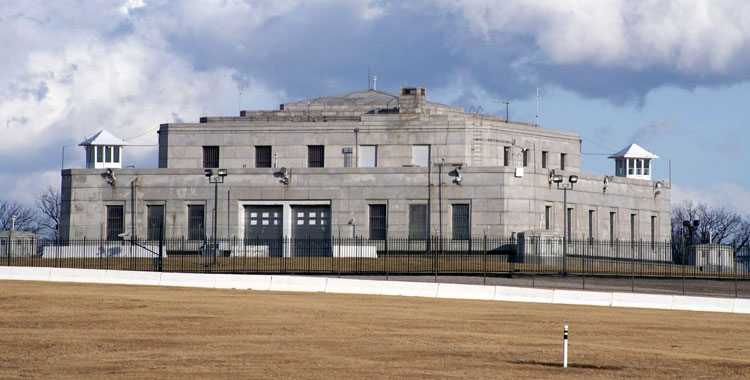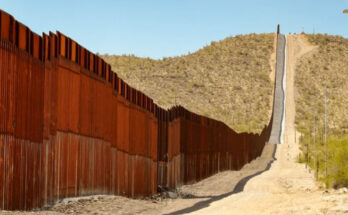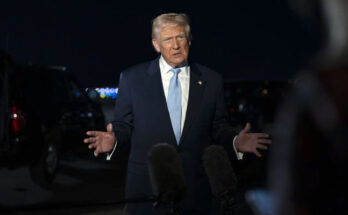Column By Mike Bibb
President Donald Trump and sidekick Elon Musk are getting down to the nitty-gritty.
Like many folks, they want to know if the United States Bullion Depository at Fort Knox, Kentucky, is full of gold. Or, as Musk recently quipped, “Is it really lead bars spraypainted gold?”
I’m sure Elon’s sarcastic comment was intended to prod public interest in the topic, but given the bizarre revelations by the Department of Government Efficiency (DOGE) of the federal government’s unshackled spending obsessions—along with unimaginable waste and fraud—then Musk’s remarks on the validity of Fort Knox gold could have substance.
However, having the President or Congressional representatives visit and view the facility may be easier said than done.
Consequently, they should consider hiring Auric Goldfinger, the bad guy in 1964’s action flick Goldfinger. This is the third movie installment of author Ian Flemming’s 25 James Bond films. Bond was the fictional British MI-6 Secret Agent 007, permanently assigned to track and thwart the world’s most conniving villains.
Excellent stunt work, camera special effects, and fantastic gimmicks, gadgets, and supercars were anticipated features in every film.
Of course, helping Agent 007 in these problematic tasks was several vixens to ease the stress and patch the scratches and occasional bullet holes piercing James’s epidermis.
It was dirty work, but someone had to do it. Usually, James was given those thankless chores. Just as predictable, we would always sail into the sunset —at the movie’s end, embracing the lucky girl.
The plot was pretty much the same in every sequel.
Finally, after performing in seven Bond movies, star Sean Connery (1930-2020) had enough of the 007 character and moved on to other acting gigs.
Anyway, Goldfinger’s storyline is about the daring robbery of Fort Knox. Using Cessna airplanes, piloted by out-of-the-ordinary curvaceous female operators, they aerosol sprayed the area with nerve gas — crop-duster style — which immediately immobilized everyone guarding the compound. Goldfinger would then detonate a “d“dirty bomb” inside the vault — since it was too cumbersome to remove the gold physically — thereby contaminating its contents and driving up the world price of the metal without him taking possession.
You get the point. Fort Knox could be robbed if conceived and carried out in a particularly sinister way. That is until super-agent James Bond was assigned to the case. Then, the ploy gradually unraveled and went downhill.
Fort Knox was saved, the gold rescued from Goldfinger’s grimy grip, and, as mentioned, 007 and the female foxes slipped away to rest up for the next installment.
Corny, but the movies made a lot of gold — the green kind.
Incidentally, in 20,03, the American Film Institute declared Goldfinger the 49th greatest villain in movies in n the past 100 years, Joining Jaws, Darth Vad, ar and Hannibal Lecter, among others.
Now, over 60 years after the first James Bond films were released, Fort Knox gold is again on the minds of various folks, including Elon Musk, who is worth several hundred billion dollars.
Only this time, the question is being kicked around: Is there gold in the depository at Fort Knox? Or could it possibly have been stolen? Not by Goldfinger’s method, but maybe by the age-old “Iinplain sight” type of caper.
It’s kind of like an “Inside job.”
In other words, everyone’s been told and naturally assumes Ft. Knox contains piles of gold—millions and billions of dollars of the stuff—neatly stacked in temperature-controlled rooms constructed of thick reinforced concrete, steel, and hardened vault doors since 1936.
Further protected by electric fences, armed guards, video surveillance, motion detectors, and other theft prevention features we can only imagine, it is virtually burglar-proof and certainly incapable of being robbed at gunpoint.
It is also fortified by the adjacent Fort Knox Army Post, a sprawling military complex home to several Army-specialized units.
“’s safe as Fort Knox!” Not even a flu germ could escape undetected.
Then there’s the other side: “If there’s something of value, someone will figure a way to steal it.” It’s just a matter of how and when.
This strategy has been demonstrated multiple times throughout history. I imagine the lure of tons of refined gold resting inside a building is a potent stimulant to anyone contemplating ways of illegally removing it.
But what if the idea was not to rush in and load the metallic booty into trucks but repeatedly—over time—pilfer smaller amounts? Each time, it would be replaced with a substitute of lesser value. The vaults would be completed, and the records would reflect nothing unusual.
Even single grains of sand can grow into large dunes if there’s enough of them.
The scoundrels wouldn’t be dressed in black with an insignia on their sleeve. Still, they would look like everyone else coming and going through the well-protected gates and portals, displaying the same identification cards, fingerprint IDs, and eye scans.
Nor would it be necessary to remove the gold by conventional means. Maybe all it would take is a little extra ingenuity, a previously untried robbery tactic, and a group of individuals thoroughly familiar with the methods and procedures of Fort Knox security.
Maybe the caper could all be run from a single desk using an ordinary laptop computer from a distant location.
With the current price of gold hovering around $2600 an ounce, a standard gold bar weighing 439 ounces (about 27.4 pounds) would cost approximately $1,141,400.00.
In today’s computer-dependence environment, the possibility of even more criminally intricate schemes is conceivable. Cybercrime computer scams happen every day, and to such an extent, several companies furnish products and services to help impede the problem.
Still, the thievery goes on — sometimes on an international scale—anconan tinuesng struggle.
Before anyone begins plotting a new Goldfinger heist of Ft. Knox, maybe they should ask themselves: If the United States monetary system is no longer linked to gold and silver as the basis of exchange, then what’s the point of hoarding vast bundles of the precious metal?
We buy goods and services and pay our bills with paper money, checks, slug coins, and credit cards. Our money has very little financial significance other than what the government and Federal Reserve banking system decide it’s worth at any given time.
This might help explain why costs always seem to increase, necessitating spending more money to purchase things.
One week an item cost a dollar, the next its gone up to a $1.10. hen, a $1.17.
Yet, there was a time when folks carried gold and silver coins in their pockets; the U.S. Mints stamped and circulated those through the Treasury Department. There was also paper money, but some silver and gold reserves backed it.
Because of their gold and silver content, the coins had a built-in value, whereas today’s money doesn’t.
The precious metal in our coins has gradually been reduced to the point that it is practically negligible. Coins are made of nickel, copper, and zinc. Paper money is produced from 25% linen (fibers from the flax plant) and 75% cotton.
Suppose copper and cotton from the Gila Valley area can become part of our nation’s currency.
Traditionally, gold and silver have been valuable items for thousands of years. Precious metals are less available than paper money or credit, which can be easily fabricated from abundant sources. They must first be mined, refined, minted into coins, and circulated within a stable banking system.
Most importantly, it’s tough to inflate and counterfeit because the process is naturally limited by its manufacturing procedures. After the coins are made from gold and silver ores, they are stamped by machines in various sizes and denominations—billions of them, all with an established value.
What would be the purpose of flooding the monetary system or counterfeiting coins with genuine gold and silver content?
Exactly — a fool’s adventure.
Let’s suppose the information stored at Fort Knox is not as great as most people think. Maybe we’ve been deceived all these years by a clever ruse intended to portray an image of absolute security when—possibly—the opposite is true.
From DOGE’s exposure to federal programs and their funding, we learn that massive corruption, waste, abuse, and outright mismanagement are more common than previously thought. It seems people are often given these jobs for political reasons rather than their experience and qualifications.
Is it just a coincidence a majority of the federal workforce are Democrats, even during Republican Administrations? I doubt it.
As a result, billions of dollars are stupidly or intentionally squandered on programs and schemes that have little merit in our country’s overall governance.
With this in mind, it isn’t surprising that President Trump, Elon Musk, and others are scratching their heads and pondering the possibility that the volume of Ft. Knox’s gold may be less than presumed or reported.
Indeed, no one would object to a deep audit of the place—to ensure the records are correct and the vaults contain what they should.
It is a bipartisan project with equal numbers of Democrat and Republican representatives witnessing the inspection. What would be wrong with that?
Unless the books are cooked, the gold is spraypainted lead bricks. And, by chance, the director of the depositors is any-looking dude named Auric Goldfinger.
Then, we might have a problem, Lucy!
The opinions expressed in this editorial are those of the author.











